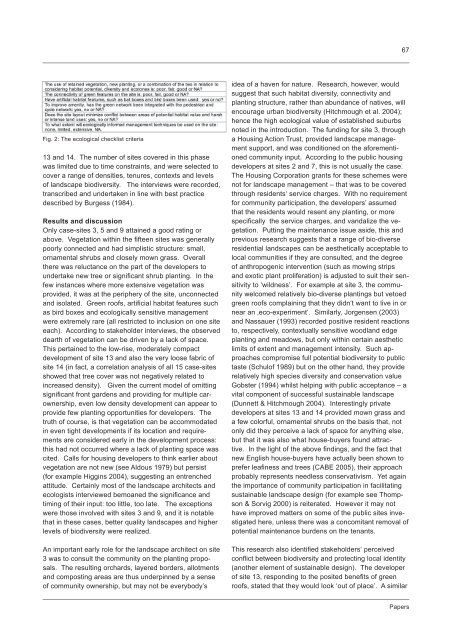Landscape – Great Idea! X-LArch III - Department für Raum ...
Landscape – Great Idea! X-LArch III - Department für Raum ...
Landscape – Great Idea! X-LArch III - Department für Raum ...
You also want an ePaper? Increase the reach of your titles
YUMPU automatically turns print PDFs into web optimized ePapers that Google loves.
67<br />
Fig. 2: The ecological checklist criteria<br />
13 and 14. The number of sites covered in this phase<br />
was limited due to time constraints, and were selected to<br />
cover a range of densities, tenures, contexts and levels<br />
of landscape biodiversity. The interviews were recorded,<br />
transcribed and undertaken in line with best practice<br />
described by Burgess (1984).<br />
Results and discussion<br />
Only case-sites 3, 5 and 9 attained a good rating or<br />
above. Vegetation within the fifteen sites was generally<br />
poorly connected and had simplistic structure: small,<br />
ornamental shrubs and closely mown grass. Overall<br />
there was reluctance on the part of the developers to<br />
undertake new tree or significant shrub planting. In the<br />
few instances where more extensive vegetation was<br />
provided, it was at the periphery of the site, unconnected<br />
and isolated. Green roofs, artificial habitat features such<br />
as bird boxes and ecologically sensitive management<br />
were extremely rare (all restricted to inclusion on one site<br />
each). According to stakeholder interviews, the observed<br />
dearth of vegetation can be driven by a lack of space.<br />
This pertained to the low-rise, moderately compact<br />
development of site 13 and also the very loose fabric of<br />
site 14 (in fact, a correlation analysis of all 15 case-sites<br />
showed that tree cover was not negatively related to<br />
increased density). Given the current model of omitting<br />
significant front gardens and providing for multiple carownership,<br />
even low density development can appear to<br />
provide few planting opportunities for developers. The<br />
truth of course, is that vegetation can be accommodated<br />
in even tight developments if its location and requirements<br />
are considered early in the development process:<br />
this had not occurred where a lack of planting space was<br />
cited. Calls for housing developers to think earlier about<br />
vegetation are not new (see Aldous 1979) but persist<br />
(for example Higgins 2004), suggesting an entrenched<br />
attitude. Certainly most of the landscape architects and<br />
ecologists interviewed bemoaned the significance and<br />
timing of their input: too little, too late. The exceptions<br />
were those involved with sites 3 and 9, and it is notable<br />
that in these cases, better quality landscapes and higher<br />
levels of biodiversity were realized.<br />
An important early role for the landscape architect on site<br />
3 was to consult the community on the planting proposals.<br />
The resulting orchards, layered borders, allotments<br />
and composting areas are thus underpinned by a sense<br />
of community ownership, but may not be everybody’s<br />
idea of a haven for nature. Research, however, would<br />
suggest that such habitat diversity, connectivity and<br />
planting structure, rather than abundance of natives, will<br />
encourage urban biodiversity (Hitchmough et al. 2004);<br />
hence the high ecological value of established suburbs<br />
noted in the introduction. The funding for site 3, through<br />
a Housing Action Trust, provided landscape management<br />
support, and was conditioned on the aforementioned<br />
community input. According to the public housing<br />
developers at sites 2 and 7, this is not usually the case.<br />
The Housing Corporation grants for these schemes were<br />
not for landscape management <strong>–</strong> that was to be covered<br />
through residents‘ service charges. With no requirement<br />
for community participation, the developers’ assumed<br />
that the residents would resent any planting, or more<br />
specifically the service charges, and vandalize the vegetation.<br />
Putting the maintenance issue aside, this and<br />
previous research suggests that a range of bio-diverse<br />
residential landscapes can be aesthetically acceptable to<br />
local communities if they are consulted, and the degree<br />
of anthropogenic intervention (such as mowing strips<br />
and exotic plant proliferation) is adjusted to suit their sensitivity<br />
to ‘wildness’. For example at site 3, the community<br />
welcomed relatively bio-diverse plantings but vetoed<br />
green roofs complaining that they didn‘t want to live in or<br />
near an ‚eco-experiment‘. Similarly, Jorgensen (2003)<br />
and Nassauer (1993) recorded positive resident reactions<br />
to, respectively, contextually sensitive woodland edge<br />
planting and meadows, but only within certain aesthetic<br />
limits of extent and management intensity. Such approaches<br />
compromise full potential biodiversity to public<br />
taste (Schulof 1989) but on the other hand, they provide<br />
relatively high species diversity and conservation value<br />
Gobster (1994) whilst helping with public acceptance <strong>–</strong> a<br />
vital component of successful sustainable landscape<br />
(Dunnett & Hitchmough 2004). Interestingly private<br />
developers at sites 13 and 14 provided mown grass and<br />
a few colorful, ornamental shrubs on the basis that, not<br />
only did they perceive a lack of space for anything else,<br />
but that it was also what house-buyers found attractive.<br />
In the light of the above findings, and the fact that<br />
new English house-buyers have actually been shown to<br />
prefer leafiness and trees (CABE 2005), their approach<br />
probably represents needless conservativism. Yet again<br />
the importance of community participation in facilitating<br />
sustainable landscape design (for example see Thompson<br />
& Sorvig 2000) is reiterated. However it may not<br />
have improved matters on some of the public sites investigated<br />
here, unless there was a concomitant removal of<br />
potential maintenance burdens on the tenants.<br />
This research also identified stakeholders‘ perceived<br />
conflict between biodiversity and protecting local identity<br />
(another element of sustainable design). The developer<br />
of site 13, responding to the posited benefits of green<br />
roofs, stated that they would look ‘out of place’. A similar<br />
Papers
















